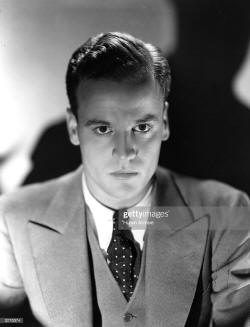

Partner Charles Walters
Queer Places:
501 Palisades Beach Rd, Santa Monica, CA 90402
9884 Santa Monica Blvd, Beverly Hills, CA 90210
22522 Pacific Coast Hwy, Malibu, CA 90265
 John
Darrow (born Harry Simpson; 17 July 1907 – 24 February 1980) was an American
actor of the late silent and early talking film eras.
John
Darrow (born Harry Simpson; 17 July 1907 – 24 February 1980) was an American
actor of the late silent and early talking film eras.
Born Harry Simpson in Leonia, New Jersey in 1907,[2] he went to Washington, DC, as a teenager, becoming known as "the handsomest page-boy in the Capitol."
Darrow began acting in theater with a stock company, right after graduating high school.[3] After selling insurance for a while, he moved to Hollywood, where his brother, Allan Simpson, had already broken into pictures. Shortly after, he would begin his film career with a featured role in the 1927 silent film, High School Hero, a knock-off of William Haines' success in the previous year's Brown of Harvard.[4] For the next several years, "Johnnie" Darrow was a popular second-rank juvenile star, a precursor of later teen idols, through The Racket, Prep and Pep, and Girls Gone Wild. By the early 1930s he was being groomed for more adult roles, supporting Ben Lyon in Howard Hughes' Hell Angels. He never quite took off, however, playing leads in Poverty Row pictures and bits in quality ones. He starred opposite Marian Marsh in "Young Sinners" in 1930, yet another flaming-youth melodrama, with "bad little boys waving flasks and cocktail glasses."
After several films with featured roles, he was cast as the lead in 1931's The Lady Refuses, which co-stars Betty Compson and was directed by George Archainbaud.[5] He would spend the next five years in leading man or featured roles, before retiring from acting in 1935. He would appear in five films that year, although four of them were produced in 1934. His final screen appearance would be in a supporting role in Annapolis Farewell.[6] Although he retired from acting, he did not leave the film industry and instead continued on to become a very successful agent.[2]
By the mid-1930s, George Cukor was not only established as a prominent director but, socially, as an unofficial head of Hollywood's gay subculture. His home, redecorated in 1935 by gay actor-turned-interior designer William Haines with gardens designed by Florence Yoch & Lucile Council, was the scene of many gatherings for the industry's homosexuals. The close-knit group reputedly included Haines and his partner Jimmie Shields, writer Somerset Maugham, director James Vincent, screenwriter Rowland Leigh, costume designers Orry-Kelly and Robert Le Maire, and actors John Darrow, Anderson Lawler, Grady Sutton, Robert Seiter and Tom Douglas. Frank Horn, secretary to Cary Grant, was also a frequent guest.[43]
From the 1930s to the early 1950s, Darrow was in a relationship with the choreographer turned director of musicals Charles Walters.[7] Darrow was known to publicly berate his lover, Walters, as a "stupid faggot." Charles "Chuck" Walters was a Hollywood director and choreographer most noted for his work in MGM musicals and comedies in from the 1940s to the 1960s. The fact that he was gay and relatively open about it, for the time—sharing a home with his longtime partner John Darrow, a prominent Hollywood agent—didn’t seem to hinder his success. John Darrow’s name was listed for events as Chuck’s plus-one.
Darrow reinventend himself as a successful Hollywood agent, so there would have been another reason for him to be there, but people knew that they were living together in Malibu (where Darrow had bought land in 1944), and they’d show up as a couple. Walters was discreet, but he wasn’t dishonest. Brent Phillips' book 'Charles Walters: The Director Who Made Hollywood Dance, illuminates Walters' private life as a gay man.
My published books: